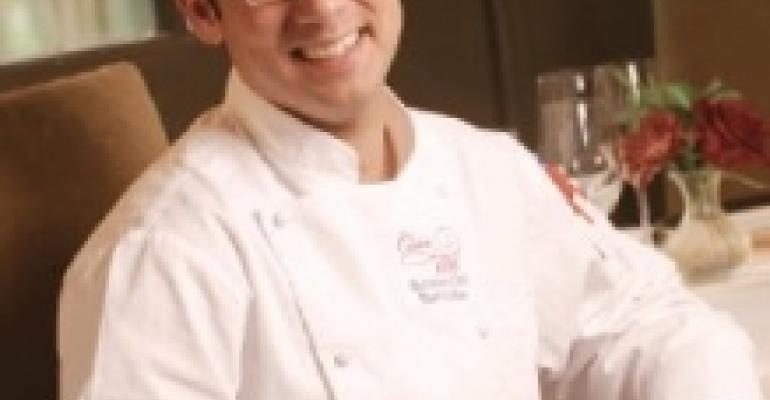 |
| SOUTHERN SCENE: Chef Marc Collins’ food at Circa 1886 (at left, below) pays upscale tribute to Low Country tradition. |
 |
You used to hear the word “sleepy” associated with Charleston, and for as long as I’ve been visiting, there has been a virtue in that. It is quiet, there’s little traffic, and the streets are mostly narrow and neighborly. The stately manses and fine Georgian and ante-bellum townhouses have never been in better shape.
Little by little, however, this languorous image has been changing so that today, without losing its southern soul or sense of hospitality, Charleston has eased into the 21st century with agreeable finesse, nowhere better evidenced than in the many new restaurants that have opened here over the past two years. Some have strong connections to old culinary traditions while others have brought those traditions into modern perspective.
To find the best of Low Country tradition, head straight for the ten-year-old Hominy Grill, a white clapboard shotgun house dating to 1897. Here, chef-owner Robert Stehling cooks up all the old dishes—soft shell crabs with baked cheese grits, country captain and a grilled boneless pork chop with a blackstrap molasses bbq sauce, sweet potato pone and sauteed greens.
In between the old and the new are a few restaurants keeping the traditions of Low Country cookery but updating them with considerable refinement. A very good case in point is Hank’s, which, with its weather-beaten cement faeade, both looks and sounds like it’s been around for ages. The waitresses can charm the fuzz off a peach. But you’re walking into a time warp here. The place was actually built from scratch only seven years ago. Don’t pass up chef Frank McMahon’s seafood e la Wando—a lavish combo of crab, shrimp, scallops and fish sauteed with butter, spring onions and sherry, served with grits.
Slightly North of Broad, affectionately known as SNOB, was one of the first restaurants in Charleston to push the envelope beyond fried shrimp and chicken. Set in a 19th-century brick warehouse, SNOB resists all temptation to change too much, relying instead on chef-partner Frank Lee’s steady focus on Low Country food at its best.
Somewhat more upscale in a clubby sort of way is the very handsome Peninsula Grill, in the stately Planters Inn. Here chef-partner Robert Carver sets a menu that aims to refine Low Country cooking into cuisine. He also does the definitive southern coconut layer cake, with coconut anglaise and chocolate lattice.
Charleston has long lacked a good steakhouse. Now it has a great one: Oak, whose every square inch and every morsel on the plate is invested with the larger-than-life personality of chef-owner Brett McKee.
There are also a few high-end places in town with national recognition. One is Circa 1886 in the stunningly restored Wentworth Mansion, where chef Marc Collins’ cooking has a sumptuousness that also reflects the kind of food affluent Southerners might have eaten each night by candlelight, like crab cake souffle, and grilled shrimp with fried green tomatoes, ending with angel’s food cake.
Two new entries show that young chefs can bring Low Country cuisine into the 21st century with highly personalized panache.
The city has long needed a restaurant like Fig, where chef-partner Mike Lata and partner-manager Adam Nemirow set the ideal, casual atmosphere full of warmth and the kind of food that becomes irresistible. Despite numerous international flourishes, Fig’s menu is quintessentially modern American.
Cordavi, opened last January, is a culinary wake-up call for Charleston; indeed, owner-chefs Corey Elliott and David Szlam have shown daring in opening a restaurant that goes far beyond locals’ expectations.
To taste the range of Cordavi, opt for the five-course $65 menu, with a $30 wine pairing option, starting with an amuse of crab cappuccino. The chefs infuse salsify with porcini and place it in delicate ravioli, served with crispy sweet-breads, crayfish tails and a lobster froth. Fresh foie gras is seared and served on French toast with a blackberry compote and fruit sorbet. Butter-poached lobster with pork belly and cauliflower risotto gets added piquancy from an onion jus. Cordavi has the best desserts in Charleston.
There’s probably good sushi and nice Italian food in Charleston, too, but I’ve never cared much to ferret it out. I’m too happy thinking about the kind of dishes Charleston chefs are doing that are part of the region’s impressive culinary evolution.





